Los Luchadores Por El Barrio didn’t expect to be booted from Knee Deep Vintage after handing its owner a calling card about gentrification in Pilsen. According to the three young artists, their performance intended to build a civil line of communication based on Adrien Piper’s calling cards — peaceful, pre-written responses to microaggressions. Whereas Piper’s cards addressed the sexist or racist remarks from acquaintances, however, Los Luchadores’ cards ask the recipients to “not appropriate our murals and culture for capitalism.”
Reportage from outlets such as DNAInfo, Chicagoist, and persistent activism from groups such as Somos Logan Square or Humboldt Park No Se Vende have effectively popularized discussion around “gentrification.” This is, I think, a good thing in terms of pushing ourselves to acknowledge rising rents, racial segregation, and disenfranchisement of poor residents as human consequences — as opposed to the “anomalies” or “necessities” of a housing market. We’re starting to publicize theories and measurements once locked away in the jargon of the academy and public policy analysts.
That said, much of this coverage has lacked nuanced representations of voices which oppose “gentrification” and those who are at risk of being displaced by it. For example, the DNAInfo articles initially reporting the vandalization of 18th street’s BowTruss cafe with anti-gentrification signs contained no quotes of folks sympathetic or in agreement with the signs. Indeed, Philip Tadros, the white businessman who owns BowTruss, was given ample space to decry the vandalization as “racist” and say they should email him with complaints. There would be later articles which cited folks from Pilsen Alliance, a local community organization, but these were broadly more diplomatic ways of saying the vandalization was some type of “wrong” or a misuse of voice.
But not everyone can afford to keep their store open in a neighborhood where over 50% of residents are paying over 30% of their income in rent, and unemployment increased by 137% from 2000 to 2010. Not everyone can afford to pass the economic, legal, and physical borders which coerce the separation between one neighborhood and another. Furthermore, not everyone has the means or capacity to communicate their dissent effectively through presumably “legitimate” channels such as policy memos, letters to alderman, or even friendly conversation.
These methods might also ring hollow when we consider the fundamentally undemocratic, repressive actions government and private enterprises have perpetrated against lower income residents of color since urban renewal policies in the 1940’s. Specifically, the Mexican community landed in Pilsen largely as a result of targeted arson and eminent domain enactions around the area which would become UIC-University Village.
Residents who have borne the brunt of these events might elect — as the BowTruss “vandals” did — to use tagging to claim their stake. They beg the same question one Luchador posed when considering Pilsen’s improved infrastructure: “I didn’t have that growing up here. Sure, it’s nice, but for who?”
By dressing up in colorful Lucha Libre masks and penning calling cards which address their discomfort with what spaces like BowTruss symbolize in “gentrifying” communities, Los Luchadores Por El Barrio are also claiming a stake. As you’ll read in the following interview, these three Latin@ performers illuminate the role of the artist in re-imagining the borders of urban territory, policy, and who is allowed to maintain a semblage of home.
***
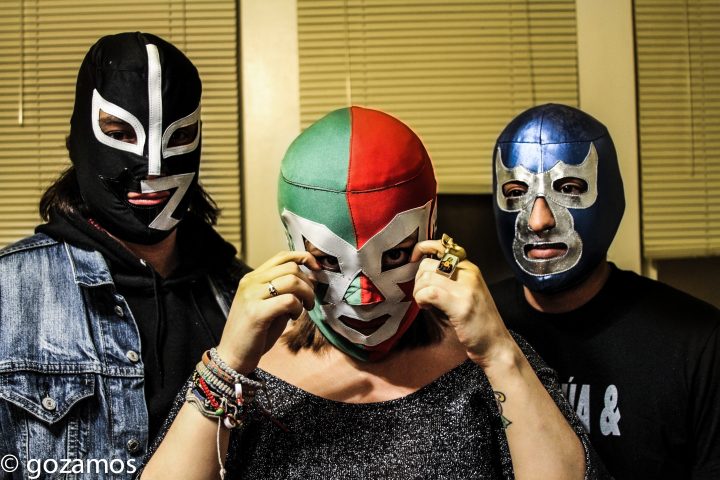
Brian: Okay, friends. Who are you?
Luchador 2: We’re just a few artists. Specifically, artists of color. I think as such we have a bit more responsibility to the community we grew up in or are a part of — or the one we come to become a part of. Speaking for myself, I come from another state (California). Usually, it can be an issue when you come into a community that’s changing as an artist — y’know, artists are usually white — and it makes a big difference coming into a place as an artist of color
Luchadora 1: As artists we have a responsibility to fight back somehow. Because, obviously, gentrification often gets started by artists, predominantly white artists who start finding out about some neighborhood which seems somehow vibrant to them, and they infiltrate, assist the system in proceeding. So, I think us as artists, especially artists of color, we have a responsibility.
B: Can you tell me the statement of purpose, the artist’s statement for the performance that you did at Knee Deep and other stores?
Luchador 2: People will call what we do “identity art,” but it’s art, and we express it because we want to express our experiences as Chicanos, as Latinos. When we started talking about what we wanted to do, we were getting frustrated with what was happening in Pilsen — I think it’s similar to what’s happening in a lot of neighborhoods, cities across the country, east coast, west coast, midwest — places that were predominantly Latino are quickly changing, and that change… is it good? Is it bad? As artists, we wanted to make people aware and make a statement; a quick statement, a powerful statement.
Luchadora 1: I think it also comes out of the frustration of learning about ASCO — [a Latino performance Group from LA] doing similar things as us — like, at the end of college or grad school. Or on your own. They were intervening in streets, writing their names on museums which weren’t exhibiting them. It’s like that ready-made idea of just doing it. I think it has to do a lot, too, with our position of not being able to financially afford to do something bigger. So we go to the store, buy the masks, and get out there to perform—making a moment and documenting that.

Luchador 2: As far as the materials we were going to use, we were very particular. We know the mascara, we know Lucha Libre — I grew up with Lucha Libre, used to go watch it. It’s very known in the community. So we decided to use the mask to represent our culture and, y’know, the way we grew up.
Luchadora 1:It’s also an iconic mask to our culture, and it also is about resilience, and it is also about celebration. So it’s really interesting to go down the street, be wearing them, and have older Mexican people or younger kids be like, “Oh, wow, that’s awesome! So cool!” and then going to the spaces we were planning on performing and have a completely different, exoctizied reaction followed by anger…
Luchador 2: …and defensiveness.
Luchadora 1: Yeah.
Luchador 2: I think what we got out of it, too, was seeing a huge disconnect between those two communities.
Luchadora 1: Yeah, 100%.
Luchador 2: We saw people who were walking away from us, and then people who were walking towards us, like, “Let’s throw down a match right now, compadre!”
B: Can you walk me through narratively how you put it together and what happened at each store?
Luchadora 1: It all started with me going to that store where we got the masks. We had already decided we were gonna do it on 18th street in Pilsen. I had a two-hour long conversation with this woman, a store owner who’d been given like a month to get rid of her stuff in her store because a new owner took over the building and they gave her only one month to leave. She was talking about how they were gonna redevelop the building into apartments, and she didn’t know what to do, so she was gonna take all of her stuff and go back to Mexico. She was telling me how there’s no way she can afford housing let alone to be renting this place after new owners came in. I thought, this is a place I should invest, so I bought the masks. We all came together that day, we put the masks on, took photographs, talked over where we were going to perform, how we were gonna perform, how to be respectful.
Luchador 2: Then we just went down 18th Street.
Luchadora 1: The first business we entered was Knee Deep Vintage. We were all talking in front of it. I remember telling [Luchador 3], who’s been in Pilsen his whole life, I remember telling him to stay calm. ‘We’re only gonna stand there for 30 seconds, give them the card, stand for another 30 seconds, turn around, and leave.’

Luchador 2: For [Luchador 3] it’s a little more difficult, he has more attachments because he grew up in Pilsen. So he’s seen it change.
Luchadora 1: He’s been here his whole life, and is experiencing gentrification directly, seeing himself not belong here is something that’s very difficult for him. He tells us about places where he used to go with his parents when he was little that are now gone; his family having to decide whether it is lucrative to stay here or not, and sell their house to move somewhere else. So we went over that, and gave the card to Knee Deep’s owner who happened to be working a shift at the time, but I remember as we were all walking in and we stood there, he started to laugh, and he was like, “Oh, this is really cool;” he thought it was funny. Then, [Luchador 3] gave him the card, and he read the first line, and he crumpled it up, told us, “Get the fuck out of my store, you mascots; I’ve been here for 10 years. You don’t know shit.”
Luchador 3: [Laughs] I felt, um, really mad. I get really hot-headed. I don’t know. It hurt my feelings — it was weird. The way he looked at me. He kinda showed violence with his words. It was very defensive. And that made me feel a little uncomfortable for sure, and really mad.
Luchador 2: We really weren’t expecting that. We were expecting a positive conversation; dialogue about what both parties can do to control this, give back to the community. After that we went to the new thrift store that’s across from Harbees and the same thing happened there: the owner crushed it, threw it at us, and said, “Okay, I know. Get out.”
Luchadora 1: It’s so strange how the mask in our culture is so celebratory and not confrontational at all. We thought that by wearing the mask and being in a Mexican-American neighborhood people would read it as a way of covering up our identity, but not in an aggressive form.
Luchador 2: That image shifted for us. Sure, lucha libre is aggressive, but we were thinking of the fandom, the people who look up to these luchadors.
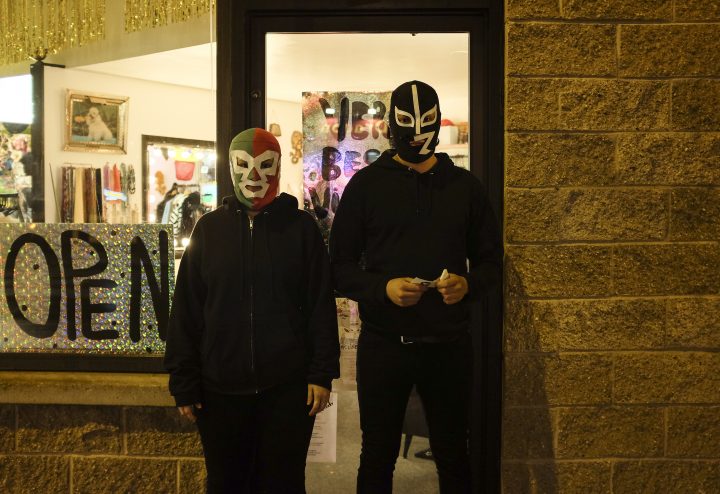
B: How did you select the Businesses you entered?
Luchador 2: We were kinda seeing which businesses a low income family wouldn’t splurge on, the kind that show a different set of values. Like, growing up, we didn’t buy expensive candles from a boutique, because we get our candles from a grocery store for, like, a dollar. Or the expensive ass thrift stores. Or, I guess, “vintage stores.” Vintage stores have 80 dollar shirts, 300 dollar jackets, worn down, and we get those at thrift stores for, like, 10 bucks. We’re seeing more and more of these stores in the neighborhood, and wondering whether any low income family goes in them. And, no, [low income families] are probably not gonna spend that kind of money.
Luchadora 1: So I think we chose based on experience: what we know to have come into the community which don’t necessarily belong to the people who’ve been here for a long time.
B: What about Bowtruss?
Luchadora 1: They were closed. But we happened to slip a card under their door. The really uncomfortable thing was that [it was] the day, or the day after the stickers happened, the ones that said, “White people out of Pilsen” or “White people leave Pilsen.”
Luchador 3: I remember those stickers. That was not us.

B: How do you all feel about those stickers? Why?
Luchador 3: I don’t like them at all.
Luchadora 1: I don’t either.
Luchador 3: ‘Cause it’s not about white people, it can be any people; Black, Mexican, whatever. If someone comes into your neighborhood and changes the culture, your culture… you’re not gonna like it, y’know? Especially as a Mexican-American who really can’t identify with being strictly Mexican or American, so en el Barrio you create your own culture and your own community. Once you feel that’s being invaded, like a piece of you is being taken away…
Luchador 2: Gentrification is very complicated. There isn’t a single, simple thing you can do to stop it. And it happens across the city.
Luchadora 1: It think another reason we didn’t like the sticker was because it is very hateful, and that’s the complete opposite of what we were trying to do. The performance was handing a card that was meant to be friendly, but also said things which were true in order to spark some sort of conversation with them. But in a safe way. To address it. To get them to think of how it is affecting the community.
Luchador 3: I think the sticker, that was a very racist thing to do. That was not our intention at all.
B: I’m gonna ask an abstract question, though Pilsen can certainly serve as a central example. Who does a neighborhood belong to?
Luchador 2: For me, whatever working class people is currently there. Of course the working class changes from time to time— it was Czech, and then Mexican-American [in Pilsen] — but these are the people who work here in the neighborhood. I feel what goes on in gentrification is the people who are coming in are okay with not having to work so hard to be here and live a good life. They are more privileged than the people currently living here.
Luchador 3: Pilsen has always been a neighborhood of immigrants, hard working, working class.
Luchador 2: I feel a certain carelessness from the new people.
Luchador 3: Not only that, but gentrification causes violence throughout the city… For example, you have gang members in the neighborhood, right? Now you kick ‘em out, and you’re just putting ‘em in a different neighborhood. They’re tatted up, 18th street, walk-out, whatever, whatever; now they have to claim another territory. That’s why you see a lot of shootings from folks who got moved to the South Side, Back of the Yards, Little Village, to a place they feel they don’t belong. Everybody’s saying Pilsen is getting better, but for who? Not for us. When we were here they didn’t do anything about it. Harrison Park was a piece of shit. There was glass everywhere. Nobody picked it up; the city didn’t care; they changed the park now, added the nice soccer park. But I didn’t have that growing up here. Sure, it’s nice, but for who?
Luchador 2: The good things came only after other kinds of people started moving in.
Luchador 3: It’s not just about people moving in, either. People move in and out of neighborhoods all the time. It’s about them moving into your neighborhood and changing your culture; changing the mural that’s been on a wall for over 20 years for propaganda or advertisement.
Luchador 2: Complaining about our music.
Luchadora 1: I guess I would say that the people who formed the neighborhood into a cultural hub own it. That’s one of the ways of identifying who “owns” a neighborhood. Because one of the most upsetting things for me is seeing people come in and not respect the culture, not participate in the events, not go to the little stores and give money to them. I think that’s one of the issues, too.
Luchador 2: It’s that carelessness. They’re basically moving in only because they see it as a cool, hip neighborhood. They don’t need to support these little shops. And that’s why we see all these expensive, unnecessary little shops popping up.
Luchadora 1: Oh yeah, like Cacti Candle.
Luchador 2: I get my candles 2 for 1 from El Güero.
Luchador 1: But now los güeros are going to El Güero.
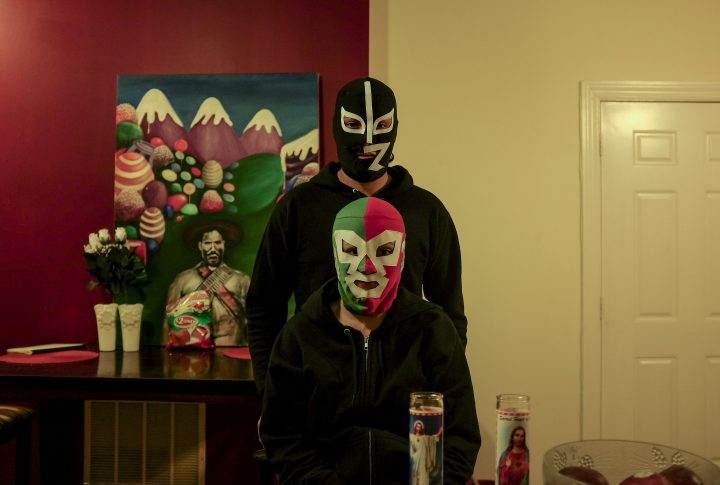
B: Have any of y’all been personally affected by displacement, or the kind of gentrification you’re talking about?
Luchador 3: I walk out and it isn’t my neighborhood anymore. What are these art events happening; what are they about? Before, I knew what was going on. Now I feel like I’m a stranger in my own neighborhood. All these yuppies know what’s up. I’ve been living here my whole life, 25 years, actually, and I guess that’s how it affects me. Financially? It’s expensive. My parents taxes just went up by a thousand bucks or something. Trying to find a place? A studio in a fucked up little shack is almost a thousand dollars. It doesn’t even make sense. What really bothers me, though, is that all these small 2 bedroom places that people are moving into used to be lived in by a family, mother, father, two kids. There’s something not right about that. It kinda gets me sad.
Luchador 2: We start seeing less people who look like us around here. Less Chicanos for sure.
Luchadora 1: There’s something weird, that hurts my stomach that happens a lot when I’m walking home for the train or walking down 18th. You see a super old Mexican person, hardly able to walk, in a sombrero, elderly man, or elderly woman — I feel like they feel like they don’t belong here. I have a feeling that when they encounter new people moving in, it makes them feel displaced even if they’re still living here. Some kind of feeling of shamefulness for being Mexican, old, and still living here while some hipster in a fur coat passes you by.
Luchador 2: Growing up, too, as a kid I was ashamed. I didn’t speak Spanish because people were gonna make fun of me.
Luchador 3: Because of the climate nowadays, if we’re walking about Pilsen, I like to speak Spanish to make sure others who pass by know that we’re of their culture, to not give off the feeling that we’re part of the problem. Because, y’know, we dress a certain way. So they think we’re white.
Luchador 2: Except… I’m kinda more moreno, y’know?
Luchadora 1: Este güey…viene de Oaxaca.
Luchador 2: When you step into a store and start speaking to them in Spanish, people are more comfortable with you. When you’re not at the panadería asking them, like, “Hey do you have any gluten-free, soy-based bread? Was that yeast harmed in the making of the bread?” That’s the thing with gentrification: they try to shape it to the way they like. I do respect folks who might not look like us, but do support events and local businesses, who show their kids Ballet Folklórico. That’s the effort you wanna see from folks who move into a neighborhood that isn’t yours. When I moved into Humboldt Park and I think I was more accepted because of my darker skin, and because I was able to converse with my neighbors in Spanish, saludarlos. Buenas tardes. There’s huge difference between some people coming in and the Latinos who move into neighborhoods like pilsen: we talk to our people, we don’t ignore them.
B: Luchadora 1 and Luchador 2, both of you are living in neighborhoods which you didn’t necessarily grow up in. Do you experience any type of guilt moving into the community?
Luchadora 1: At first I did, a little bit. But having the history of my father living here for a long time before meeting my mom, coming here during summer to visit family in Little Village. I shop local. I invest in local places. On top of that, I was teaching art classes in the neighborhood for at-risk youth.
B: I think one of the questions people who are entering a neighborhood ask often (perhaps too often) is, “If I’m a gentrifier, how do I become a good person? How do I absolve my guilt?”
Luchadora 1: I get that so often!
Luchador 2: I got that question from a friend of mine from U of C who is trying to move to Pilsen. “How can I not become a gentrifier? Help me?” And I told her, ‘Wow, you asking me that at all is really surprising. Obviously her being caucasian is the biggest difference between her and I coming into a neighborhood, and that’s a difficult thing to overcome because there’s always gonna be people who judge her more. She symbolized some change that’s gonna happen in the building or the block she’s moving into.
Luchador 3: I think as long as you respect the culture. I think it is important not to change the name of it. Like, these corporations who want to take over Pilsen’s little mom and pop shops. For example, Wicker Park used to have all kinds of small businesses, and one of those got bought up and turned into a Starbuck’s. That’s what they want to do here: take a little cafe’ and make it a Starbuck’s. The banks wanna raise the property values. I think sometimes we’re part of the problem, too. My friend Danny was renting an apartment for $750. His landlord came and told him that they were gonna start changing the rent, it was gonna go up to $950. Danny said to him, “Dude, I’ve been living here for seven years! How are you gonna do this?” His landlord said if he didn’t pay there’s someone else who will. And this guy, this landlord, is Mexican.
Luchadora 1: But, then, you also have to think about the fact the landlord’s taxes are getting raised.
Luchador 3: Sure, but that’s dramatic, from $750 to almost a thousand dollars?
Luchadora 1: Honestly, if someone asked me how to come into the neighborhood and not be a gentrifier, I’d just tell them not to move here. It’s radical, but… I’d say, don’t come here, not yet, because it isn’t stable and all these people are moving in really drastic ways. Maybe wait until they make some affordable housing unites to help people stay, not be displaced, and afford these spaces. Then maybe you can come in and not affect it so much. I feel like right now it’s a rush of people coming in; they can afford these places. But there’s no safety net for the people who are currently living here. There isn’t enough affordable housing. There’s some, but not enough. There’s student affordable housing. But the condos are gonna be built pretty soon — and I think less than 10% of them will be affordable housing.
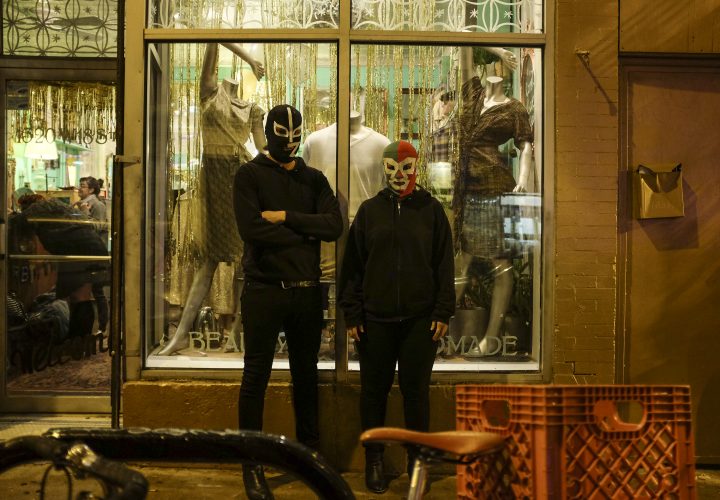
B: And that’s their floor, I think; that’s how much they legally have to do, so the developers aren’t exactly doing the neighborhood a favor by parsing out 10% of their units for low income residents.
Luchadora 1: We need 100%. If somehow the community could come together and form a safety net for people living here, then people could start safely start coming in. But I think people moving in here isn’t just about looking for cheap rent, it’s also about the exotification of this site, specifically. All the trendy places here, those used to be other businesses. These people could afford to move to another place that is already gentrified all the way…The only reason they’re coming here is because it seems vibrant to them. It’s like colonialism.
Luchador 3: It’s the pilgrims and Indians all over again.
Luchadora 1: That’s why there should be no guilt in us entering a space that is made for people like us. There aren’t a lot of those places that exist.
B: A lot of people say Pilsen is “irreparably gentrified,”that there’s “no turning back.” How would you de-gentrify an area? Can you think of a way to battle that?
Luchador 2: It starts with state and local funding. What’s made folks so marginalized is that there isn’t funding for black futures, brown futures. We see where the money is going in the city; it’s going downtown, or mostly middle-class-upper-class neighborhoods. We see that job growth in the south side and the west side is generally less than 1 percent. All these neighborhoods ask for is quality education, housing, and other resources that allow us to thrive.
Luchador 3: I think it’s hard to get an education because of how the situation is around here. People in Pilsen, for example, usually have factory jobs making $350 a week, and the taxes which come out of whatever they make fund the schools in their neighborhood. That’s why you see people in the North Side — lawyers, professionals — they have the best schools. We are at a disadvantage in terms of how education is funded. Growing up, my mom worked two jobs, my dad worked two jobs. They used to leave us at the Boys and Girls Club until 10 or 11, until they closed, Monday through Friday. Weekends we didn’t do shit because our parents were tired. At the Boys and Girls Club I saw some shit! There was gangbangers there at the age of 10, these little kids getting recruited. By the time they are in high school they’re already joining a gang because they’ve got nothing else to go far. That’s why I hate it when people say it’s because of bad parents. You don’t know what these kids’ struggles are. These kids hardly spend time with their parents. Kids elsewhere have nanny’s, daycare; we didn’t have shit.
Luchador 2: Our moms were over there taking care of the white babies.
Luchador 3: Yeah! By the time we were in high school, everyone was in gangs. It’s hard for people to learn when people are fighting, getting stabbed, starting shit. Other kids don’t want to be in gangs, but they got cousins in a gang, so they get bullied so bad they have to join one because they can’t go to the bathroom without being beat up. They need protection. The system is fucked up. I feel now— con la gentrification thing — we don’t have the education to afford these houses and these other people are coming in and taking it all. My generation didn’t have enough resources.
Luchador 2: There’s no way, I think, to reverse gentrification, but I think the system isn’t really working for low income communities.
Luchador 3: I don’t think you can stop it. Because it’s about money, man. And if you don’t have any, you can’t play the game.
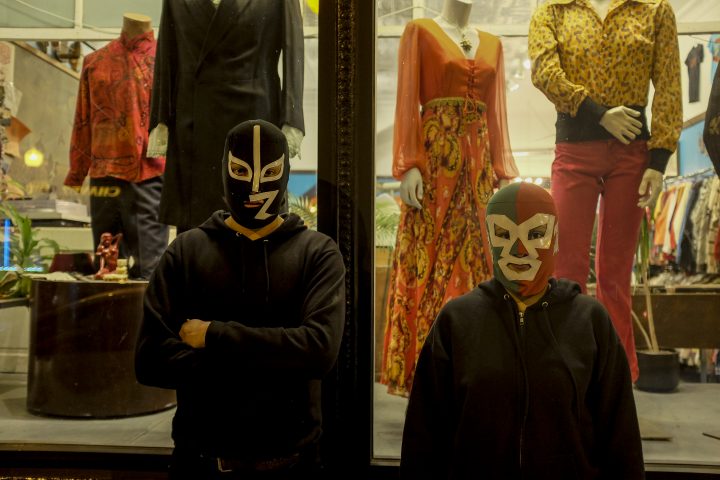
B: Sharon Zukin, an urban studies scholar, spoke of artists as a “creative class” and a preceding factor to the entrance of upper class gentrifiers. What do you think is the artist’s role in resisting gentrification and perhaps pushing back against destructive kinds of neighborhood change?
Luchador 2: What I know is that there’s a lot of universities who have students who want to move in to Pilsen.
Luchadora 1: You can go back to early painting, master oil painters, and they were exotifying different places, whether it be Fiji islands, Mexico, anywhere that was a “non-western” part of the world. I feel like artists in general tend to exotify a certain culture iconography. Maybe an artist, as I’d said, think the neighborhood is vibrant because of all the murals, but the murals hold a specific history of struggle of being of color, of being Mexican-American, and of being here. I think artists can see it as something lucrative, as something maybe visually exciting, but they don’t actually understand it. That’s why I think that the question of whether or not people should come to Pilsen is so hard, because everyone would have to have a similar moral feeling of not coming here. If you’re an artistyou’d have to acknowledge that you’re coming here only because it seems intriguing to you. I feel, though, that a lot of times artists get used as tokens for the movement of gentrification.
B: There’s kinds of Mexicanness that are easily commodified or digestible, and I think that’s the wall people have to dance on: what kind of mural is idealistically “Mexican,” in-complexly Mexican, or has a type of Mexicanidad which can be easily sold so that someone in a condo can feel cool. What I really appreciated about your performance is its audacity: there are three real life people being in front of you and telling you some shit you probably don’t wanna hear about how you’re a gentrifier, about how you need to look at Mexican residents of Pilsen as full humans. So I really appreciate that. Being unapologetic about your own culture. That can be scary to some people.
Luchador 2: I think when people complain about our rancheras, like, these nacos… we love it. It’s ingrained in us.
Luchadora 1: What’s crazy is that when we had gotten together to talk about doing the performance, we felt really positive. We thought people would feel bad and want to say, hey, sorry, this is what I can do.
Luchador 3: But, you know what? I’m kinda glad we got to do this, because I saw the people behind their masks. I saw how they really don’t give a shit. And that fucking shocked me. The energy was horrible.
Luchadora 1: I thought that this was gonna bring [shop owners] down to a human-being level. And have them feel ownership over their position in this neighborhood. But, instead, I felt like they were telling us, “actually, you guys don’t belong in this neighborhood, so get the fuck out.”